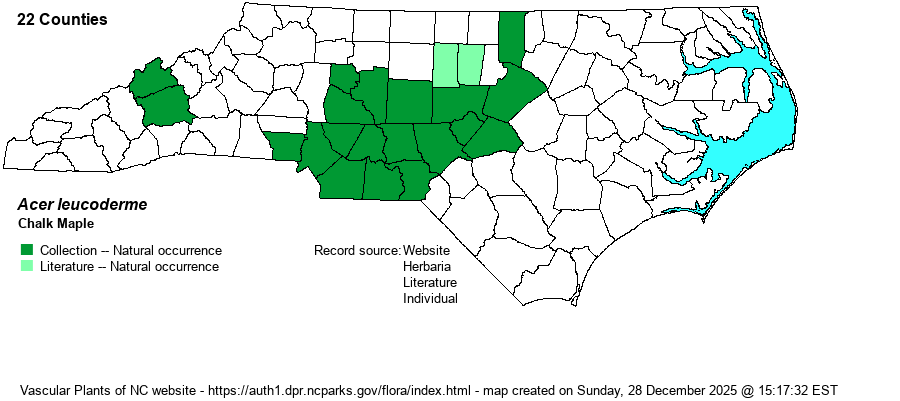| Author | Small | |
| Distribution | Generally limited to the southeastern half of the Piedmont. Ranges north to Granville and Davie counties and west to Gaston County. Very limited in the Mountains, where known only from Madison and Buncombe counties (it does occur in neighboring TN counties). Absent from the Sandhills and Coastal Plain.
A Southern species ranging north only to northern NC, eastern TN, and southeastern OK, south to western FL and eastern FL. It is primarily found in the Piedmont province, and also in the Ouachita Mountains of AR and OK.
| |
| Abundance | Uncommon to locally fairly common in the southern two tiers of Piedmont counties, mainly Montgomery to Cabarrus and south to the SC line. Rare to uncommon farther to the north and northeast, particularly scarce (very rare to rare) in the Triangle area. Extremely rare in low elevations in the Mountains. | |
| Habitat | This is a species of dry and often rocky woods and forests, mainly over circumneutral soil. The topography can be flat (such as mafic flats and hardpans) to fairly steep, such as on some slopes in the Uwharrie Mountains. Some sites can be mesic, as long as the soil is circumneutral to slightly acidic. | |
| Phenology | Flowers in March and April, and fruits from May to September. | |
| Identification | This is a rather poorly known tree to many biologists, easily passed over as a Florida Maple (A. floridanum) or less so a Red Maple (A. rubrum). Unlike most maples, this is a small deciduous tree, normally ranging (sprawling) to 25 feet tall, and typically (but not always!) with several trunks instead of a single one; if a single trunk, it is usually leaning or crooked. The bark on the trunk tends to be whitish to pale gray, hence the name “chalk” in the common name. The opposite leaves have three to five long-pointed lobes, somewhat more triangular than on other maples, but with entire margins. The central lobe is often bent or curled somewhat downward/under. Florida Maple is easily confused with Chalk Maple, but the latter has more triangular than square lobes, has leaves that are the same shade of green (or slightly paler) beneath rather than distinctly paler green, and often has multiple trunks and more crooked branches. Some leaves on Chalk Maple can look very similar to those of Florida Maple, with square-shaped lobes, so check the leaf underside color and the trunk (Florida Maple always has a single and straight trunk). The species is often encountered in much of the southern Uwharrie Mountains, as well as on wooded flats in the southern Carolina Slate Belt. | |
| Taxonomic Comments | Some to many older references, including RAB (1968), included Chalk Maple as a subspecies of Sugar Maple, named as A. saccharum ssp. leucoderme. Most recent references rightfully consider this as a good species.
| |
| Other Common Name(s) | Whitebark Maple | |
| State Rank | S3S4 | |
| Global Rank | G5 | |
| State Status | | |
| US Status | | |
| USACE-agcp | | |
| USACE-emp | | |

